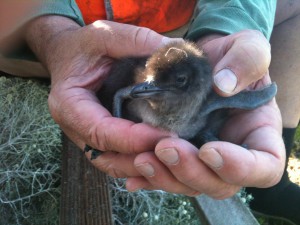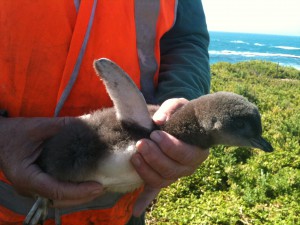Life on land – a look at the breeding season of the Little Penguins, Middle Island
Each year at the start of Spring, the volunteers for the Warrnambool Coastcare Landcare Group prepare to get their feet wet in the fortnightly journey to Middle Island. Over the months that follow, the team gain important information on the breeding activity of the Little Penguins at Middle Island. During their breeding period, the adult penguins will be spending a lot more time on land – pairing, ‘honeymooning’, preparing nests or burrows, and hopefully raising their young to successfully take to the sea.
It is an energy-expensive mission. Not only do the penguin adults frequent the sea to feed and fatten themselves up, but they also share duties of incubating their eggs, guarding, feeding and preening their young once hatched. It will take around eight weeks for a hatchling to fully fledge and leave the nest. When hatched, a little penguin chick will weight just 45 grams – about 4 percent of its parents’ body weight. By the time they are ready to leave the nest eight weeks later, the fledgling will weigh about the same as it’s parents – 900 to 1200 g.
The breeding team hope to capture some of this information by observing a number of artificial and natural burrows on the island frequently over the breeding season. The team assess the number of adult birds occupying the burrows, take measurements on their weight and sex, as well as monitor if they have eggs, chicks and the relative age of the chicks. By collecting this information across the season, the group can assess the breeding success of the colony, such as the number of breeding pairs, the number of chicks fledged from the colony, and the number of eggs that are successfully hatched.
The team also undertakes microchipping of adult and fledgling birds. By having a unique identifier, the team can also assess the proportion of fledglings that return to the colony (a form of mark-recapture study), track the mating and breeding behavior of individuals over a number of seasons, and also share information with other groups such as the Phillip Island Nature Park, to look at the distribution and movement of birds across their south eastern Australia range.
So far this season the team has assessed 40 potential burrows. Of these, nine have been found to be active. Of the nine, six adult pairs have laid eggs. One adult (female) has completed a double brooding – successfully hatching two pairs of chicks in the season. This is quite a rare event and suggests that these adults have been able to feed well and keep good condition. Three pairs of chicks have also reached fledgling stage and we hope they have been successful in making their way to sea and finding food!

A young chick (1 to 2 weeks) from Middle Island, closely guarded and attended to by one parent during the day
The team has also encountered a number of abandoned eggs, and the footage of the Wildiaries camera shows a monitored burrow has lost one chick. Like any animal, little penguins will naturally have a lower than perfect success rate with raising their young. Little penguins have approximately a 60% success rate in hatching of eggs. This may be due to a number of factors including predation, heat or cold stress, and parental inattention. The pair of chicks in one brood also do not have a naturally equal chance of survival, with parents often selecting for the strongest nestling by feeding it first. Usually less than 50 percent of pairs will successfully fledge two chicks. Extreme recent conditions, such as the above 40 degree temperatures last week, puts obvious stress on the birds, and while we should accept that these conditions are a natural part of the bird’s lives, the team has also made some additional shelter for a few of the nest boxes to better insulate them from the heat.

A mid-stage chick (4 to 6 weeks) from Middle island, now spending most of the day independently until the parents return to feed the chick after dusk
Looking ahead, the team will continue the breeding surveys until the end of March, monitoring clutches of chicks that are raised towards the end of the season. Once adults have completed the raising of their young, they will undergo another vital stage of their life cycle – moulting. This annual shedding and replacement of their feathers ensures their plumage maintains its condition, which assists in their buoyancy, swimming and insulation at sea. Following this, the breeding team will have a well-earned break, until the adventure starts again next Spring.

